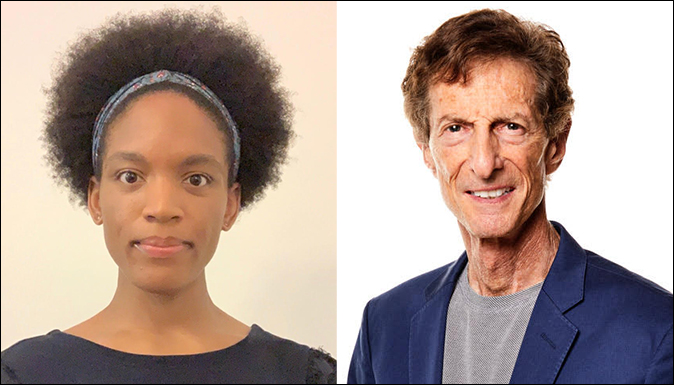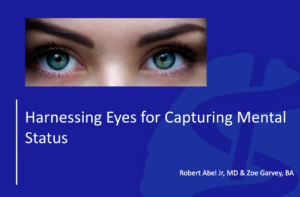Garvey ’20, Abel ’65 Collaborate on Mind-Eye Connection Research


After graduating from Wesleyan last May, Zoe Garvey ’20 had plans to conduct research at a local hospital, but the COVID-19 pandemic hindered that plan. As an aspiring physician who is taking a gap year before enrolling in medical school, Garvey began browsing the Wesleyan Alumni Directory, looking for any potential, comparable leads.
“I wanted to see if any Wesleyan alumni who were physicians would be able to offer me opportunities to work with them during my year off,” she said.
And that’s when she connected with Dr. Robert Abel Jr. from Wesleyan’s Class of 1965. Abel, Garvey learned, was a Delaware-based ophthalmologist, a former clinical professor of ophthalmology at Thomas Jefferson University, and is the author of The Eye Care Revolution, which teaches patients how to treat and manage common vision problems.
 Since June, Garvey has worked as Dr. Abel’s research assistant. Together, they’ve explored the topic of the mind-eye connection. In addition to putting together a presentation titled “Harnessing Eyes for Capturing Mental Status” for the American Psychiatric Association, they’re now working on a study regarding how mental status can be seen through people’s eyes and how vision represents 80% of our connection to the world and 90% of our memories.
Since June, Garvey has worked as Dr. Abel’s research assistant. Together, they’ve explored the topic of the mind-eye connection. In addition to putting together a presentation titled “Harnessing Eyes for Capturing Mental Status” for the American Psychiatric Association, they’re now working on a study regarding how mental status can be seen through people’s eyes and how vision represents 80% of our connection to the world and 90% of our memories.
An essay titled “Believe Half of What You See . . . Maybe Less!” based on their recent study is below:
The eye provides 80% of our sensory connection to the world. The visual process connects the information that comes from the retina to how we think; it is our headlights in the dark. There are 100 times as many nerves connecting the eye to the brain than there are connecting the ear to the brain. The “Vision Boulevard” incorporates the eyes, brain, and mind in order to orient and interpret the world around us. Since the retina is an extension of the forebrain, it should come as no surprise that our eyes and brains are intimately connected and actually evolved together when humans became upright. It turns out that if you fool the eyes, you will surely fool the mind.
Our vision is never truly objective, due to the constant flickering movements of the eyes and the mind’s bias from prior experiences. At every instant, each of us engages two eyes and two minds simultaneously attempting to direct perception; we have concurrent central macular vision, peripheral vision, conscious minds, and unconscious minds at play. Our exquisitely perceptive macula, the center of the retina, comprises merely 1.1% of our visual field. And the object of our attention is constantly being interrupted by undetected saccades (five flickering movements per second), torsion movements (due to the ligament connections from the toes to the orbits), and frequent blinking. Furthermore, our retinas only see in two dimensions and must extrapolate from incomplete information. As a result, our brains are multitasking all the time and if visual input fluctuates, the mind can only be deceived.
Photography provides an excellent example of how we manipulate an image and how that image manipulates us. We have been teaching psychiatrists to observe the external eye in order to diagnose ten specific mental illnesses. The size of the palpebral opening, the brow, the movement of the eyes (since humans are the only ones you can observe the white of the eye), and the pupillary reactions divulge our subconscious thoughts. Lee and Anderson, after seven years of studying facial identification, recognized that merely observing the eyes was the critical feature. Nearly 90% of the time, their students were able to associate one of six emotions with multiple photographs of paired eyes. Even when asking the students to evaluate the emotion when observing a disconnected appearance between the eyes and lower face, the students were able to identify the correct emotion 68% of the time.
By presenting patients with specific computer images, psychologists and psychiatrists can interpret mental status by the choices patients make, and support determining diagnoses. In the 1920s, Rorschach attempted to correlate subconscious ideation with visual interpretation.
Currently, multiple studies document the value of multiple-choice iPad images, virtual reality, and augmented reality in assessing mental status. The results have furthered diagnosis and therapy while providing benchmarks for improvement. These techniques are even effective in split-screen virtual visits, which allow the therapist to observe patients’ eyes while presenting them with multiple-choice imagery.
Knowledge about the intricacies of our visual connections should augment our understanding of how we view others and ourselves as we continue to adapt in an ever-changing world.
Garvey can be reached at zgarvey@wesleyan.edu, and Abel can be reached at abeleyes@gmail.com.

